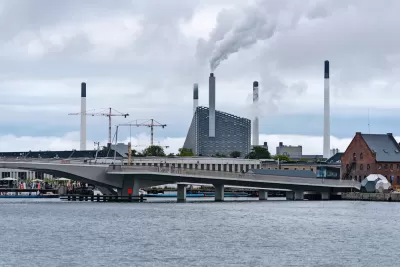Bettina Kamuk, global market director for Ramboll, explains how a Copenhagen waste-to-energy facility meets air quality and emissions standards while providing low-carbon energy and recreational activity to the surrounding community.

With China no longer accepting imports of post-consumer recyclables from the United States, California’s waste facilities are struggling to manage the sudden increase in volume and demand on its waste disposal facilities. Waste-to-energy conversion plants—a staple of European circular economic models to address waste management and reach decarbonization goals— face, despite success in Europe, significant public relations and political challenges in U.S. cities.
To better understand the latest innovative science behind waste-fired power plants globally, TPR recently toured Amager Bakke, a waste-to-energy plant (and, yes, ski slope attraction) in Copenhagen, Denmark; and, spoke with Bettina Kamuk, Global Market Director for Ramboll, who explained how the Copenhagen facility meets air quality and emissions standards while providing low-carbon energy and recreational activity to its surrounding community.
"The Amager Bakke waste-to-energy (WtE) facility, which we engineered and designed, supplies one-third of all heat to Copenhagen, and is part of Denmark’s 2010 national strategy to reduce all dependency on fossil fuels by 2030. The Amager Bakke WtE facility is owned and operated by Amager Resource Centre (ARC), a five city consortia, to supply low-carbon electricity to 550,000 people and district heating to 140,000 households.
This plant replaced a 45-year-old facility. ARC’s objectives were to replace the aging lines of this facility, produce a lower emission, more efficient plant that would have a higher recovery of materials like metals, and be a beacon for the city, open to the public. Everyone knows that we are building a ski slope on the roof and that this facility is in the center of the city. We don’t hide what we’re doing. We show what we’re doing with our waste."
Read the full interview on The Planning Report.
FULL STORY: Denmark's Amager Bakke Waste-to-Energy Plant: a Global Model of Sustainable Design & Efficiency

Trump Administration Could Effectively End Housing Voucher Program
Federal officials are eyeing major cuts to the Section 8 program that helps millions of low-income households pay rent.

Planetizen Federal Action Tracker
A weekly monitor of how Trump’s orders and actions are impacting planners and planning in America.

Ken Jennings Launches Transit Web Series
The Jeopardy champ wants you to ride public transit.

Crime Continues to Drop on Philly, San Francisco Transit Systems
SEPTA and BART both saw significant declines in violent crime in the first quarter of 2025.

How South LA Green Spaces Power Community Health and Hope
Green spaces like South L.A. Wetlands Park are helping South Los Angeles residents promote healthy lifestyles, build community, and advocate for improvements that reflect local needs in historically underserved neighborhoods.

Sacramento Plans ‘Quick-Build’ Road Safety Projects
The city wants to accelerate small-scale safety improvements that use low-cost equipment to make an impact at dangerous intersections.
Urban Design for Planners 1: Software Tools
This six-course series explores essential urban design concepts using open source software and equips planners with the tools they need to participate fully in the urban design process.
Planning for Universal Design
Learn the tools for implementing Universal Design in planning regulations.
Heyer Gruel & Associates PA
Ada County Highway District
Institute for Housing and Urban Development Studies (IHS)
City of Grandview
Harvard GSD Executive Education
Toledo-Lucas County Plan Commissions
Salt Lake City
NYU Wagner Graduate School of Public Service


























